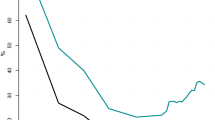Abstract
Rent Control in Britain began in the First World War and has lasted, on and off, most of this century. There has been almost no new building for private rent since 1939. The private rented sector is small (8%), marginalized, delapidated, and unattractive.
The British Government is enacting new legislation to reform all areas of rented housing. Rents of new lettings will be freely agreed (i.e., at market levels) between landlord and tenant. But the tenant has security of tenure, subject to renegotiating a new rent. The absence of any important tax incentives or other subsidy was an obstacle to revival even with market rents. But the Business Expansion Scheme proposal in the March 1988 budget has created considerable interest among investors.
Similar content being viewed by others
References
Aldridge, T.Rent Control and Leasehold Enfranchisement. 8th ed. London: Oyez Publishers, 1980.
Arden, A.The Private Tenants' Handbook. London: Allison and Busby, 1985.
Audit Commission.Managing the Crisis in Council Housing. London: HMSO, 1986.
Bone, M. and Mason, V.Empty Housing in England. London: HMSO, 1980.
Coleman, A.Utopia on Trial. London: Hilary Shipman, 1985.
Committee on the Rent Acts.The Francis Report. Cmnd. 4609. London: HMSO, 1971.
Daunton, M. J.A Property-Owning Democracy? Housing in Britain. Historical Handbooks. Faber and Faber, 1987.
Department of the Environment.Housing and Construction Statistics 1975–1985. London: HMSO, 1986.
.Housing: the Government's Approach (the Housing White Paper). Cmnd. 214. London: HMSO, 1987.
.Assured Tenancies; Monitoring Exercise 1987. London: DoE, 1987.
.The Private Rented Sector: The Government's Legislative Proposals (mimeo). Consultative Paper. London: DoE., 1987.
Department of Health and Social Security.Housing Benefit Review: Report of the Review Team. Cmnd. 9520. London, HMSO, 1985.
Edinburgh, HRH The Duke of.Inquiry into British Housing: Report and Evidence (two volumes). London: National Federation of Housing Associations, 1985.
Evans, A. W.House Prices and Land Prices in the South East-A Review. London: House Builders Federation, 1987.
General Household Survey. London: HMSO, 1978.
Greater London Council (GLC).Private Tenants in London. The GLC Survey 1983–84. London: GLC, 1986.
Holland, SirMilner.Report of the Committee on Housing in Greater London. Cmnd. 2605. London: HMSO, 1965.
Holmans, A. E.Housing Policy in Britain: A History. London: Croom Helm, 1987.
Johnson, J. H., Salt, J., and Wood, P. A.Housing and the Migration of Labour in England and Wales. Saxon House: Lexington Books, 1974.
Leeds Residential Property Association.A New Start for the Private Rented Sector. Leeds: Leeds Residential Property Association, 1987.
Maclennan, D.Housing Economics. London: Longman, 1982.
Minford, P., Peel, M., and Ashton, P.The Housing Morass, Regulation, Immobility and Unemployment. Hobart Paperback 25. London: Institute of Economic Affairs, 1987.
National Association of Home Builders.Home Building after Tax Reform: a Builders Guide. Washington: National Association of Home Builders, 1986.
Power, A. “Housing Case Study: Difficult to Let.”Architects' Journal 176 (1982), 659–671.
Power, A. “Rescuing Unpopular Council Estates through Local Management—Trouble in Utopia.”Geographical Journal 150 (1984), 351–362.
Ricketts, M.Lets Into Leases. London: Centre for Policy Studies, 1986.
Salt, J. “Labour Migration, Housing and the Labour Market.” In: A. Evans and D. Eversley, eds.,The Inner City: Employment and Industry. London: Heinemann, 1980.
Salt, J. “Labour Migration and Housing in the UK: An Overview.” In: C. Hamnett and J. Alden, eds.,Labour Markets and Housing. London: Hutchinson, in press.
Stahl, K. and Struyk, R. J.US and West German Housing Markets. Washington: The Urban Institute, 1985.
Tingle, R.Housing and Mobility in Scotland. London: Aims of Industry, 1986.
Todd, J., Bone, M., and Noble, I.The Privately Rented Sector in 1978. London: HMSO, 1982.
Todd, J. E.Recent Private Lettings 1982–84. London: HMSO, 1986.
Whitehead, C. M. E. and Kleinman, M. “Private Renting in London: Is It So Different?”Journal of Social Policy 16 (1986), 319–348.
Author information
Authors and Affiliations
Additional information
Paper for conference on Rent Control: The International Experience, John Deutsch Institute Roundtable, Kingston, Ontario, 2 September 1987
Rights and permissions
About this article
Cite this article
Coleman, D. Rent control: The British experience and policy response. J Real Estate Finan Econ 1, 233–255 (1988). https://doi.org/10.1007/BF00658919
Issue Date:
DOI: https://doi.org/10.1007/BF00658919




